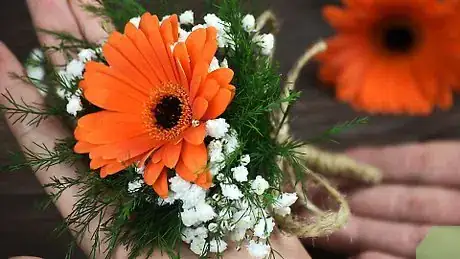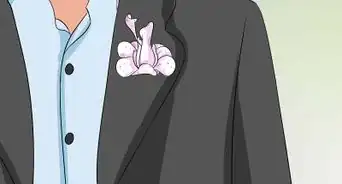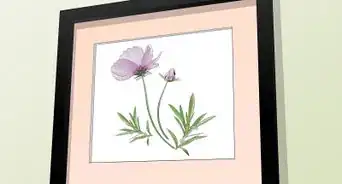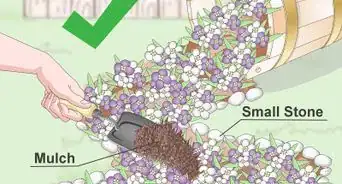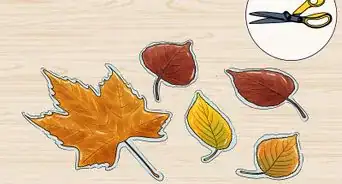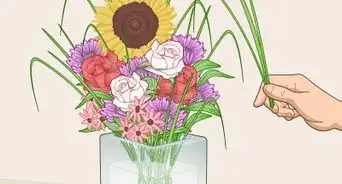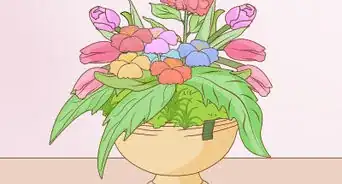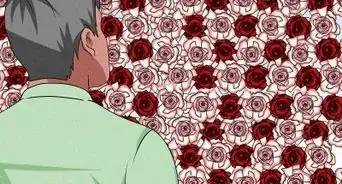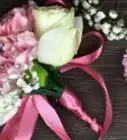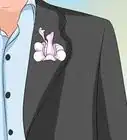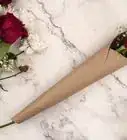This article was co-authored by Lois Wade and by wikiHow staff writer, Hunter Rising. Lois Wade has 45 years of experience in crafts including sewing, crochet, needlepoint, cross-stitch, drawing, and paper crafts. She has been contributing to craft articles on wikiHow since 2007.
There are 11 references cited in this article, which can be found at the bottom of the page.
wikiHow marks an article as reader-approved once it receives enough positive feedback. In this case, 80% of readers who voted found the article helpful, earning it our reader-approved status.
This article has been viewed 188,223 times.
Boutonnieres are small floral arrangements worn on jacket lapels during formal events, such as a wedding or prom. You can buy boutonnieres from local florists, but you can make your own with a few simple supplies at home. After you select the flower you want to use for your boutonniere, all you need to do is add wire, tape, and any additional decorations you want. When you’re finished, you’ll have a boutonniere that’s unique and stylish.
Steps
Getting the Flower Ready
-
1Choose a large flower for the middle of your boutonniere. You can pick any flower that you want for your boutonniere. Make sure the flower has a sturdy stem so your boutonniere doesn’t wilt.[1]
- Pick a flower that’s the same color or a complementary color of your clothes. For example, if you were wearing a purple tie, choose a purple or yellow flower for your boutonniere.
- Use artificial flowers if you don't have access to fresh ones.
Tip: The 4 most common flowers to use in boutonnieres are roses, carnations, calla lilies, and tulips.[2]
-
2Remove any deformed petals around the outside of the flower. Pull out the 2-3 outer petals around the flower so it looks completely fresh. If there are any other damaged petals, take them out until you’re happy with the flower’s appearance.[3]
- If you notice that you have to remove a lot of the petals, try to use a different flower. Your boutonniere will look less full when you take out too many petals.
Advertisement -
3Snip the stem 1 inch (2.5 cm) below the bud. Use a pair of garden snips to cut the stem off of the flower. Measure about 1 inch (2.5 cm) from the base of the flower and make your cut at a 45-degree angle. Dispose of the stem once it’s removed.[4]
- Trim some of the leaves off of the stem before you throw it away if you want to use them as decoration in your boutonniere later on.
Wrapping the Stem
-
1Stick an 8 in (20 cm) piece of floral wire through the base of the flower. Push one end of the wire right underneath the flower’s base. Make sure your wire is in the middle of the stem so your boutonniere stays balanced. Feed the wire through the other side of the stem until you have 4 inches (10 cm) on each side.[5]
- If you’re using silk or other artificial flowers, heat the end of the wire with a candle or utility lighter. The hot wire will melt through the plastic to the other side.
- If you can’t find floral wire, any 22-24 gauge wire will work fine.
-
2Fold the wire in half to create a fake stem. Point each side of the wire down and away from the flower. The wire makes a stem that you can bend and manipulate more easily. Make sure the wire is completely straight.[6]
Tip: You can bend the wire at slight angles to give a more rugged shape similar to a natural flower stem.
-
3Wrap the wire tightly in floral tape. Place your tape just above where you put the wire through the stem. Hold the tape in one hand and use your other hand to slowly spin the flower. Pull the floral tape tight, and press it against the wire stem so it adheres. Continue wrapping tape around the wire until you reach the bottom.[7]
- Floral tape can be purchased at your local arts and crafts store.
Adding Additional Greens and Decoration
-
1Group leafy filler plants around the base of the flower and tape them in place. Choose leaves that are flat, but not too large that they overwhelm your flower. Arrange the greenery around your flower so their stems extend down past the wire. When you have an arrangement that you like, wrap another layer of florist’s tape around the stems the same way as your wire.[8]
-
2Tie ribbons around the stem to add more color to your boutonniere. Wrap the ribbon around your boutonniere the same way you wrapped the tape. Tuck each end of the ribbon into the wrap to hold it in place.[12]
- If you want a more decorative look, leave one end of the ribbon hanging down and cut a small triangle out of the end to form a dovetail.
-
3Trim the wire down to 2–3 in (5.1–7.6 cm). Use a strong pair of scissors to cut the boutonniere to a smaller size so it fits on your lapel easier. This also helps remove any long stems from your filler plant to make your boutonniere look cleaner.[13]
- Curl the end of your boutonniere backward if you want to secure a ribbon even more.[14]
Things You’ll Need
- Flowers
- Garden snips
- 22-24 gauge wire
- Floral tape
References
- ↑ https://www.curbly.com/how-to-make-a-boutonniere
- ↑ https://www.liveabout.com/best-boutonniere-flowers-3490451
- ↑ https://youtu.be/JDd__gAm_oc?t=59
- ↑ https://madeinaday.com/how-to-make-a-boutonniere/
- ↑ https://madeinaday.com/how-to-make-a-boutonniere/
- ↑ https://madeinaday.com/how-to-make-a-boutonniere/
- ↑ https://youtu.be/JDd__gAm_oc?t=95
- ↑ https://www.onefabday.com/diy-boutonniere/
- ↑ https://www.onefabday.com/diy-boutonniere/
About This Article
To make a boutonniere, start by choosing a large flower with a sturdy stem for the middle of your boutonniere, like a rose, carnation, or tulip. Then, remove any deformed or damaged petals and snip the stem 1 inch below the bud. Next, stick a piece of floral wire through the base of the flower and fold it in half downward to make a fake stem, wrapping it in floral tape to cover it. Finally, group leafy filler plants around the base of the large flower, like holly or plumosa, and secure them with floral tape. To learn how to decorate a boutonniere with ribbon, scroll down!

